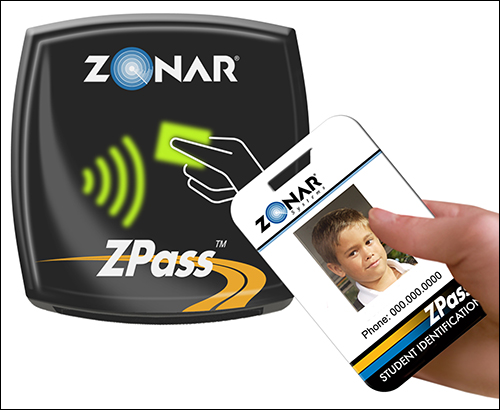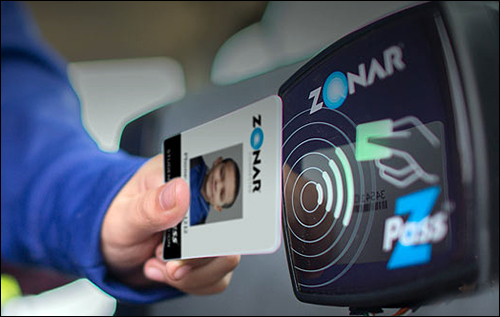Tens of thousands of school buses, mostly in large urban districts, are equipped with RFID-enabled systems to track the locations of their young passengers. Nearly a decade ago, telematics and fleet-management technology company Zonar Systems released its Z Pass solution for student rider visibility, and the adoption rate has been building. The company plans to integrate its solution into a Zonar tablet as a next-generation version, to further improve ridership visibility by displaying if a student or other passenger leaves a bus at the wrong stop.
For users such as companies offering private passenger service, the firm has now released a lower-cost, non-RFID-enabled version that employs a sensor to simply count the number of riders in a bus or other vehicle without identifying who they are. That spares the company using the system from distributing cards at all—it can simply track the number of bodies passing the sensor as they enter and leave the vehicle.
The Z Pass system consists of low-frequency (LF) RFID badges that identify each passenger, as well as a Zonar 2020 high-frequency (HF) 13.56 MHz RFID reader compliant with the ISO 15693 standard. The reader comes with a GPS unit and a camera, provides cellular functionality and is mounted on a vehicle’s dashboard. It transmits read data to software on Zonar’s own hosted server, which authorized parties can then access via a portal by entering the proper password, says Kevin Mest, Zonar’s senior VP and general manager of passenger services.
Without the Zonar technology, the company explains, parents have little visibility into where their children are while being bussed to and from school. A parent looking to determine whether his or her child boarded the correct bus, as well as where that child disembarked, would need to call the student (assuming he or she had a cell phone) or call the school or transportation department. This lack of visibility can become a problem if a student fails to turn up where expected—in some cases, a small child can exit a bus at the wrong stop, board the wrong vehicle or fall asleep in the back of the bus, which may not be discovered until later in the day.
The Seattle-based technology company began piloting the Z Pass system with local school districts approximately eight years ago, and has since sold the product to school districts and bus systems across the United States. According to Mest, a third of the nation’s 480,000 buses now use the technology and many are adopting Z Pass.
With the Z Pass solution, students carry an HF RFID tag built into an ID badge that can be carried or attached to a backpack. Although no identification information is printed on the badge, with the exception of a serial number, the ID number encoded on the RFID tag is linked to the student’s identification in the Zonar software, on what is called the Ground Traffic Control server.
As each child enters a bus, he or she holds the RFID tag within a few centimeters of a Zonar reader, which captures the unique ID number of that student’s tag. The reader can then forward that ID, along with a GPS-based location and a time and data stamp, to the Ground Traffic Control server via a cellular connection. “The reader acknowledges each read with an audio beep,” Mest explains, “and the system knows the student got on [and] where, along with the date and time stamp.”
The Zonar software links the ID number to the specific student and his or her expected route. In that way, perimeters can be set up so that an alert will be triggered in the event that a student exits a bus at an unexpected stop, for example, or does not leave the vehicle at all.
School districts and transit managers can view the data in real time, in order to ensure that students reach their destination, as well as when they arrive. They can also use the data as proof of ridership when submitting reports to the state for funding purposes. What’s more, the technology can be used in the event of an emergency. If a bus accident occurs, for instance, authorities will immediately know who was on the bus so that every parent can be notified.
Parents concerned about their children’s location or safety can sign into the system and view where their kids got onto and off of a bus, as well as when this occurred. Zonar also offers a Z Pass app with which parents can view when and where their child scanned the card on their iOS or Android smartphone or tablet.
The system is intended not only to provide peace of mind to parents, but also to save school personnel from the distraction of phone calls and attempts to locate students. Most importantly, it is designed to prevent safety concerns in the event that a child becomes lost by leaving a bus at the wrong time, or takes the wrong bus. Furthermore, the technology can be used by companies that provide vehicles for shuttle or other transportation services.
Zonar Count “is the ‘crawl’ part of the Z Pass solution,” Mest says of the typical “crawl, walk, run” process. Some companies may not want to identify every passenger, or are working their way up to a full tracking system. In this case, the technology simply identifies the number of people aboard a particular vehicle, so that a user—such as a company with a shuttle service for its employees—can better understand its ridership and thus optimize its vehicle fleet, routes and schedules.
The next generation Z Pass system will provide further functionality that could prevent errors before they can occur, Mest says. The system includes an app on a tablet mounted in each bus. The software knows which stop the child should be using (for example, the appropriate school, and the stop closest to his or her home), so if a student taps a badge against the reader at the wrong location when leaving the bus, an alert will be displayed on the tablet, enabling the driver to stop the child from making a mistake.




